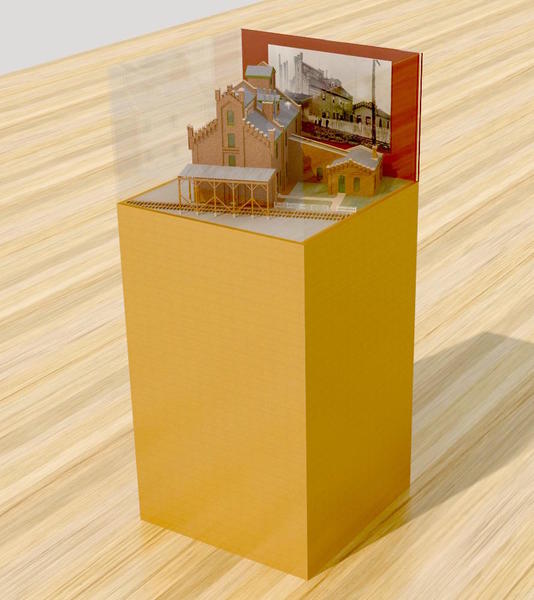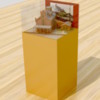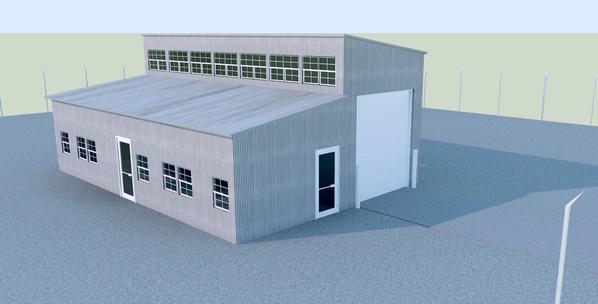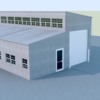Lights, lights and more lights.
Decided to run the lighting power for the big tank through the tank itself like I did with the distillation tower. I used the Dremel to open up a nice sized hole in the base to fish the wires. I was able to capture them with a long tweezers and didn't need a separate fish wire.

Topside, I CA'd the light into the hole drilled through the reinforcing block I added yesterday and then, before feeding the wire through the tank, added a piece of shrink tubing to help conceal (a bit) the wire as it turns inwards. I'm sure this is a prototypical no-no, but the conduit that would have been on the real tank is so small in 1:48 that it wouldn't carry any wires. The 1/8" tubing for the lights may be a bit heavy (6 scale inches), but it's the only size that will work for me with the kinds of LEDs I'm using. If I was using the type that some use with the magnet wire leads, smaller tubing would work.
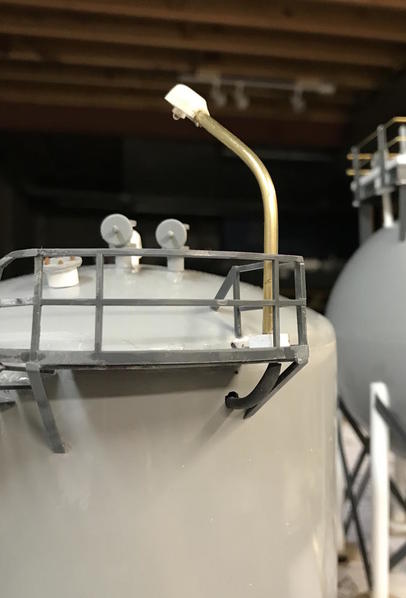
I also did a similar thing bringing the wires down through a leg on the multi-tank platform.

From the viewing distance, these wire tricks will be very hard to see.
I then added two lights to the roof of the cooling tower. Again, I first reinforced the mounting points by adding thick stuff underneath. I drilled corresponding holes in the bottom of the CT box and then, using a transfer punch, located the same holes in the Masonite base which the wires will pass through to the layout's nether regions.
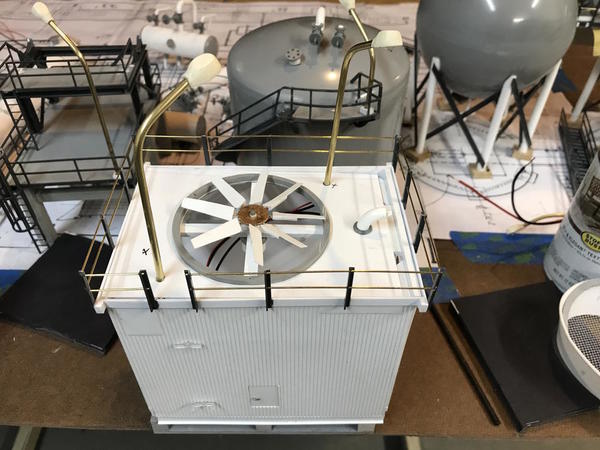
After looking at this picture, I suddenly realized that I positioned these lights from underneath basically paying attention to interference with internal structures, totally ignoring the topsides problems which may occur. I ran downstairs while writing all this and put the venturi on to see if it cleared the poles. Whew! It does. Barely. As Mark Knopfler sings, "You get lucky sometimes."
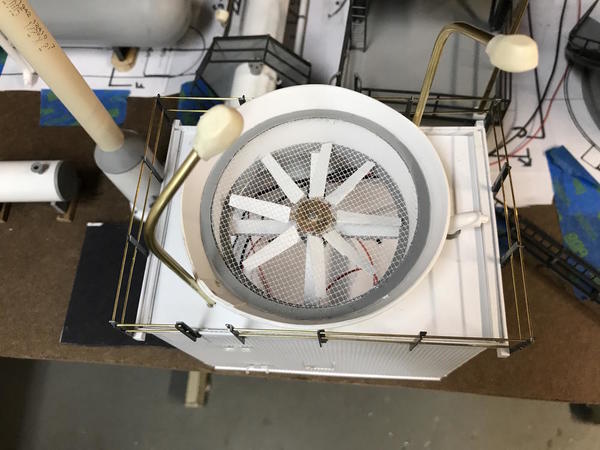
With the cooling tower lit, all the unit mounted lighting is done. I still had some surface mounted fixtures to build. I figured six more will do the trick. As it is, this thing is going to light up like an amusement park. I'm mass producing this batch. I pre-bent all the LEDs, pre-bent all the tubes, drilled the negative lead hole in the bottom end after sanding a flat spot to facilitate drilling, and soldered them all up.
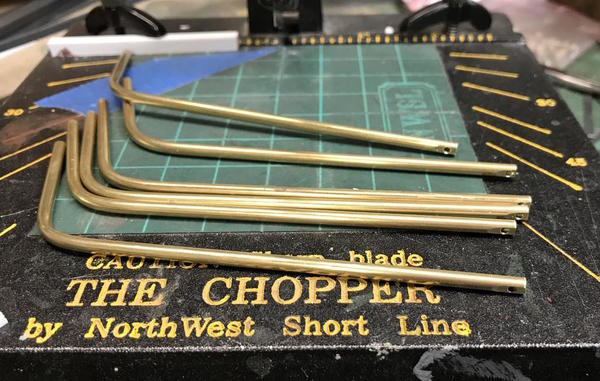
I thought I show a closeup of the LED soldering even if I show it a long time ago when building the Substation or the silo system, since it's something that folks might like to reproduce for themselves. After wrapping the + Lead around the + LED lead, soldering it and then putting small shrink tubing around it to isolate it from the tube (which is the negative lead), I carefully wrap the negative LED lead over the tube's bottom, again supporting the lead between the bend and the head. I need to keep the tube top clear since the light hood gets glued there. I use a little bit of extra rosin flux to promote adhesion and using the Weller iron with a broad tip and temperature set a 3+, I solder the lead to the tube by heating the tube to get the solder to flow. You should be able to see the contour of the conductor under the solder. The solder flow should be concave, not convex. Convex indicates bad adhesion with the solder's surface tension is causing it to ball up. Usually this means not enough heat on the substrate or unclean surfaces.
Remember: Don't bend LED leads at the head. If you do, the stress will kill the LED. Hold long nose pliers under the head and bend away from the pliers. Always!

Here are all six new lights waiting for the guy who's casting the resin parts to get his act together.
And sometimes you don't get lucky... While doing all this, I wrecked several LEDs. First, I test the LEDs before soldering anything. Then I test the fixture again when all the wiring is done, but before the hood is CA'd on. Remember, the pole is negative. I have a test rig that is 12VDC with a positive lead and two negatives; one with a 470 ohm current limiting resistor and one straight through. If I testing the lighting installed in a structure it will have its own current limiter so I could run straight 12 VDC. I had the positive lead on the + power, and accidentally brushed the tube over the un-protected negative. The LED lit....ONCE, and then it was gone. I desoldered it and replaced it.
Then I couldn't find the bag of LEDs that was supposed to be right in front of me on the workbench. I looked all over the place. Then I see it. Behind me... rolled over by my chair caster. Several were deformed, and one I tested was kaput. Murphy's law at work.
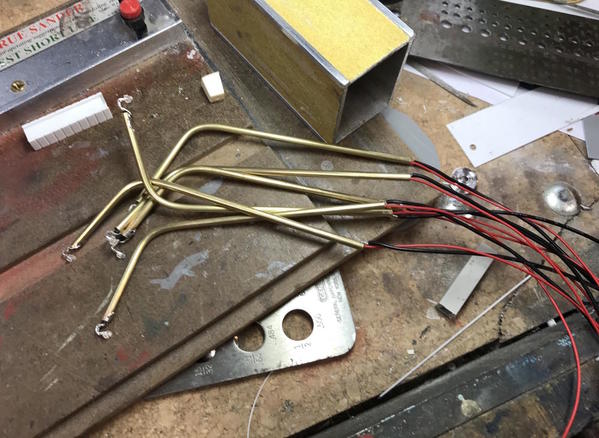
For the ground mounted fixtures I have a resin mold of a faux concrete base. I've also shown this before, but it bears repeating. Since this is a tapered part and needs a square-flat bottom, I made a sanding fixture that supports the part at the correct position vertically and horizontally so I can sand the bottom with the Precision Sander.
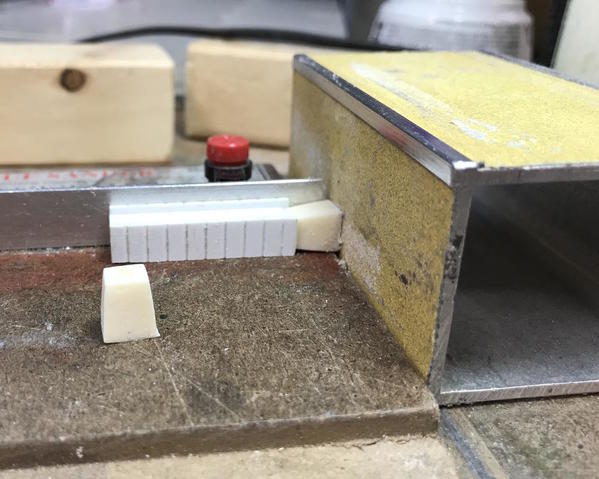
I cast a dimple into the top so drilling would be easy. But I also needed a jig to hold it square on the table. A vise was too strong and would damage the fragile resin. This hole goes clean through. The fixture's hole is just a tad smaller than the overall size of the base so the base sits tightly when inserted from underneath the jig. All this means that I can reproduce these parts over and over.
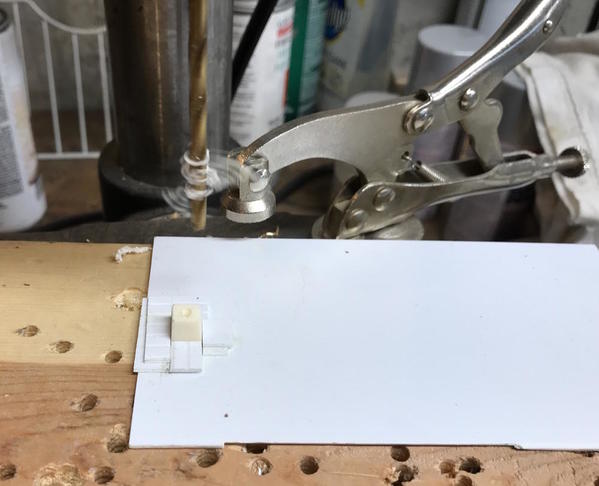
Lighting will be done as soon as I can cast the remaining parts. Then it's on to the pipe racks and hangers. That means sometime next week it all goes to the paint shop. Then I have to build the ops building and all that fencing so it clearly won't all be finished when I wanted to, but it will be quite far along.
I need to buy more caged ladders to go to the top of the flare tower. I also want to put the flashing lights on top which should another tricky fishing expedition.




